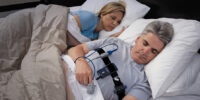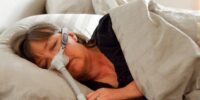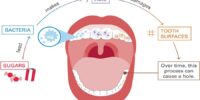Can Sleep Apnea Be Triggered By Allergies Or Environmental Factors?

Sleep apnea is a common sleep disorder characterized by repeated pauses in breathing during sleep. It can lead to various health issues, including daytime fatigue, high blood pressure, and heart problems.
While the causes of sleep apnea are multifactorial, recent research suggests that allergies and environmental factors may play a role in triggering this condition. Allergies, such as hay fever or allergic rhinitis, can cause nasal congestion and inflammation, leading to obstructed airflow and contributing to sleep apnea episodes.
Additionally, environmental factors like exposure to certain pollutants or irritants may also exacerbate sleep apnea symptoms. Understanding the link between allergies, environmental factors, and sleep apnea is crucial in developing effective management strategies.
This article explores the connection between allergies, environmental factors, and sleep apnea, as well as offers tips for managing these factors to improve sleep apnea and overall sleep quality. Seeking professional help and making lifestyle changes are key steps towards reducing sleep apnea episodes and improving overall well-being.
Key Takeaways
- Allergies, such as hay fever, can contribute to sleep apnea by causing nasal congestion and inflammation.
- Exposure to pollutants and irritants in the environment can worsen symptoms of sleep apnea.
- Minimizing exposure to common allergens, such as dust mites, pet dander, pollen, and mold, is important for managing sleep apnea.
- Allergy medications and environmental control measures, such as regular cleaning and using air purifiers, can help alleviate sleep apnea symptoms.
Understanding Sleep Apnea
The etiology of sleep apnea remains a topic of ongoing research, with various factors such as genetics, obesity, and craniofacial abnormalities being implicated as potential triggers.
Sleep apnea is a common sleep disorder characterized by repetitive episodes of partial or complete obstruction of the upper airway during sleep, resulting in intermittent cessation of breathing. These episodes can lead to disrupted sleep patterns and inadequate oxygen supply to the body, potentially causing various health complications.
While the primary cause of sleep apnea is often attributed to anatomical or physiological factors, emerging evidence suggests that allergies and environmental factors may also play a role in triggering or exacerbating the condition.
Allergic rhinitis, for example, has been associated with an increased risk of sleep apnea, possibly due to nasal congestion and inflammation.
Similarly, exposure to environmental pollutants such as cigarette smoke or air pollution has been linked to a higher prevalence of sleep apnea.
Further research is needed to explore the complex interplay between allergies, environmental factors, and sleep apnea, as well as their potential implications for prevention and treatment strategies.
Allergies and Sleep Apnea
Allergic reactions and external elements may contribute to the development of sleep-disordered breathing, such as sleep apnea. Allergies can cause inflammation and congestion in the nasal passages, which can obstruct the airways during sleep. This obstruction can lead to interruptions in breathing and result in sleep apnea episodes.
Additionally, environmental factors such as exposure to allergens and irritants in the bedroom can also trigger or worsen sleep apnea symptoms. Common allergens include dust mites, pet dander, pollen, and mold. These allergens can irritate the respiratory system and lead to swelling and narrowing of the airways, further obstructing normal breathing patterns during sleep.
Therefore, it is important for individuals with sleep apnea to identify and manage any allergies or environmental factors that may contribute to their condition to ensure effective treatment and improved sleep quality.
Environmental Factors and Sleep Apnea
Exposure to various irritants can significantly exacerbate the severity of sleep-disordered breathing, including sleep apnea. Environmental factors play a crucial role in the development and progression of this disorder.
Several studies have identified a link between air pollution and sleep apnea, suggesting that individuals living in areas with high levels of pollution are more prone to developing the condition.
Additionally, exposure to allergens such as dust mites, pet dander, and pollen can trigger allergic reactions, leading to nasal congestion and inflammation, which in turn can worsen sleep apnea symptoms.
Furthermore, indoor allergens like mold and volatile organic compounds (VOCs) emitted by household products can also contribute to sleep apnea.
Therefore, it is important to minimize exposure to such environmental factors and maintain a clean and allergen-free sleeping environment to manage sleep apnea effectively.
The Link Between Allergies, Environmental Factors, and Sleep Apnea
One significant connection can be observed between the presence of irritants and the severity of sleep-disordered breathing, specifically in relation to the development and progression of the condition. Allergies and environmental factors have been found to contribute to the occurrence and exacerbation of sleep apnea.
- Allergens, such as dust mites, pet dander, and pollen, can trigger allergic reactions that lead to nasal congestion and inflammation of the airways. This can result in obstructed breathing during sleep, leading to sleep apnea.
- Environmental factors like air pollution and exposure to cigarette smoke can also worsen sleep apnea symptoms. These factors can irritate the airways, increase inflammation, and disrupt normal breathing patterns during sleep.
- In addition, certain environmental conditions, such as high humidity or mold growth, can create an environment conducive to the proliferation of allergens and respiratory irritants, further contributing to sleep apnea.
Understanding the link between allergies, environmental factors, and sleep apnea is crucial for effective management and treatment of the condition. By addressing and minimizing exposure to these triggers, individuals with sleep apnea may experience improved sleep quality and reduced symptoms.
Managing Allergies and Environmental Factors to Improve Sleep Apnea
This paragraph introduces a discussion on managing allergies and environmental factors to improve sleep apnea.
The key points to be discussed are allergy medications and treatments, as well as environmental control measures.
The paragraph is written in an academic style, which is objective and impersonal, and does not include any personal pronouns.
Allergy Medications and Treatments
Allergy medications and treatments are often employed to alleviate symptoms associated with allergies and may potentially help manage sleep apnea triggered by allergic reactions or environmental factors. These medications work by reducing the body’s immune response to allergens and decreasing inflammation in the airways.
Some common allergy medications include antihistamines, decongestants, nasal corticosteroids, and leukotriene modifiers. These medications can provide relief from symptoms such as nasal congestion, sneezing, and itching, which can improve sleep quality for individuals with sleep apnea.
In addition to medication, other treatments such as immunotherapy, also known as allergy shots, may be recommended for individuals with severe allergies. These shots gradually expose the body to small amounts of allergens, helping to build tolerance over time.
Overall, allergy medications and treatments can play a significant role in managing sleep apnea triggered by allergies or environmental factors.
- Antihistamines: These medications block the action of histamine, a chemical released during an allergic reaction, to reduce symptoms like itching and sneezing.
- Decongestants: These medications help relieve nasal congestion by constricting blood vessels in the nasal passages.
- Nasal corticosteroids: These medications reduce inflammation in the nasal passages, relieving symptoms such as congestion and postnasal drip.
Environmental Control Measures
Environmental control measures can be implemented to reduce exposure to allergens and improve overall air quality.
One such measure is maintaining a clean living environment by regularly vacuuming and dusting surfaces.
It is also important to keep windows closed to prevent outdoor allergens from entering the space.
Additionally, using air purifiers with high-efficiency particulate air (HEPA) filters can help remove airborne allergens.
Bedding should be washed regularly in hot water to eliminate dust mites.
Using hypoallergenic mattress and pillow covers can further reduce exposure to allergens.
Furthermore, minimizing the use of products with strong scents, such as perfumes and air fresheners, can help prevent respiratory irritation.
Overall, implementing these environmental control measures can contribute to reducing allergic triggers and potentially improving sleep apnea symptoms.
Seeking Professional Help for Sleep Apnea
Seeking professional assistance is crucial for individuals with sleep apnea in order to effectively manage their condition and improve their overall quality of life. Sleep apnea is a complex disorder that requires a comprehensive approach to treatment. While lifestyle modifications and environmental control measures can provide some relief, they may not be sufficient for everyone. Consulting a healthcare professional who specializes in sleep medicine is recommended to accurately diagnose the condition and develop an individualized treatment plan.
The table below provides an overview of the different healthcare professionals who may be involved in the management of sleep apnea:
| Professional | Role |
|---|---|
| Sleep Specialist | Specializes in diagnosing and treating sleep disorders, including sleep apnea. |
| Ear, Nose, and Throat (ENT) Specialist | Assesses and treats any anatomical abnormalities that may contribute to sleep apnea. |
| Pulmonologist | Focuses on diagnosing and treating respiratory conditions, including sleep-related breathing disorders. |
These professionals work together to provide a multidisciplinary approach to managing sleep apnea. They may recommend various treatment options, such as continuous positive airway pressure (CPAP) therapy, oral appliances, or surgical interventions, depending on the severity and underlying causes of the individual’s sleep apnea. Seeking professional help ensures that individuals receive appropriate care and support to effectively manage their condition.
Lifestyle Changes to Reduce Sleep Apnea Episodes
Transitioning from seeking professional help for sleep apnea, it is crucial to address lifestyle changes that can help reduce the frequency of sleep apnea episodes.
Adopting a healthy lifestyle can significantly contribute to managing this condition. Regular exercise, for instance, aids in weight management, which is important as obesity is a known risk factor for sleep apnea.
Additionally, avoiding alcohol and sedatives before bedtime is essential as they can relax the muscles in the throat, potentially worsening the condition.
Maintaining a consistent sleep schedule and sleeping on your side instead of your back may also help alleviate symptoms.
Furthermore, addressing underlying allergies or environmental factors such as dust mites, pet dander, or pollen can contribute to managing sleep apnea.
Implementing these lifestyle changes can potentially enhance the quality of sleep and minimize sleep apnea episodes.
Frequently Asked Questions
What are the common symptoms of sleep apnea?
Common symptoms of sleep apnea include loud snoring, frequent awakenings during sleep, gasping or choking episodes, excessive daytime sleepiness, morning headaches, difficulty concentrating, irritability, and depression. These symptoms can significantly impact a person’s daily functioning and overall quality of life.
How is sleep apnea diagnosed?
Sleep apnea is diagnosed through a comprehensive evaluation that includes a patient’s medical history, physical examination, and sleep study. Polysomnography, the gold standard test, measures various parameters to determine the presence and severity of the condition.
What are the potential complications of untreated sleep apnea?
The potential complications of untreated sleep apnea include high blood pressure, heart disease, stroke, diabetes, depression, and an increased risk of accidents due to daytime sleepiness. Treatment is important to prevent these complications.
Are there any natural remedies or alternative treatments for sleep apnea?
There are some natural remedies and alternative treatments that may help alleviate sleep apnea symptoms. However, it is important to note that these options should not replace medical treatment and should be used under the guidance of a healthcare professional.
Can children develop sleep apnea?
Children can develop sleep apnea, a condition characterized by pauses in breathing during sleep. It can be caused by factors such as enlarged tonsils or adenoids, obesity, or craniofacial abnormalities. Allergies and environmental factors may also contribute to its development.











